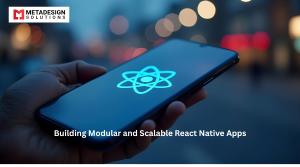React Native’s evolution brings a new architecture designed to enhance performance, improve interoperability, and streamline the development process. The introduction of Fabric and TurboModules marks a significant shift in how React Native apps interact with native applications.
At MetaDesign Solutions, we’ve delved into this new architecture to leverage its benefits. In this blog, I’ll explain Fabric and TurboModules, their advantages, and how they impact React Native development services.
The Motivation Behind the New Architecture
The original React Native architecture relies on a “bridge” to communicate between JavaScript and native code. While effective, this approach has limitations:
- Performance Bottlenecks: The bridge can become a bottleneck for high-frequency updates.
- Complexity: Managing asynchronous communication adds complexity.
- Limited Flexibility: Difficulties in integrating with native user interface (UI) components.
Goal: Overcome these challenges by redesigning the core architecture, enabling scheduled updates and better interoperability with native platforms.
Introducing Fabric
What is Fabric?
Fabric is the new rendering system in React Native that revamps how the UI layer interacts with the native application. This new architecture working group ensures that the architecture is optimized for performance and scalability, and it addresses many of the shortcomings of the legacy renderer.
Key Features
- Synchronous Communication
- Direct Calls: Enables synchronous communication between JavaScript and native code.
- Reduced Overhead: Eliminates the need for the bridge in certain scenarios.
- Concurrent Rendering Support
- Compatibility with React Concurrent Mode: Allows React to prepare multiple versions of the view hierarchy simultaneously.
- Smooth User Experience: Enhances animations and interactions.
- Simplified UI Layer
- Unified Components: Easier integration of native and custom components.
- Performance Optimization: More efficient rendering pipeline, enabled by default.
Benefits of Fabric
- Improved Performance: Faster rendering and reduced latency.
- Better Integration: Seamless incorporation of native UI elements.
- Enhanced Developer Experience: Simplified codebase, improved debugging, and better internals of React Native.
Understanding TurboModules
What are TurboModules?
TurboModules reimagine how native modules are registered and accessed in React Native, focusing on lazy loading and efficient initialization, which makes them a great choice for the future of React Native development.
Key Features
- Lazy Loading
- On-Demand Initialization: Modules are loaded only when required, reducing unnecessary load at startup.
- Faster Startup Times: Reduces initial app load time by not loading unused modules.
- Simplified Bridge Interaction
- Direct Invocation: Calls to native modules are more direct and efficient.
- Improved Performance: Less overhead in communication between JavaScript and native code.
- Type Safety
- Strong Typing: Uses TypeScript and Flow for type definitions.
- Error Reduction: Catches issues at compile-time, improving app stability.
Benefits of TurboModules
- Efficiency: Optimized module loading and execution.
- Scalability: Better handling of large numbers of modules.
- Maintainability: Cleaner and more manageable code for long-term development.
How to Adopt the New Architecture
Enabling Fabric and TurboModules
Note: As of now, Fabric and TurboModules may still be in development or require specific configurations. Always consult the official React Native documentation for the latest instructions.
Steps:
- Update React Native: Ensure you’re using React Native 0.76 or later, which supports the new architecture.
- Enable Flags: Set flags in your build configurations to activate Fabric and TurboModules.
- Migrate Modules: Update your native modules to be compatible with TurboModules.
- Testing: Thoroughly test your app to identify and fix any issues that arise due to the new architecture.
Example Configuration:
bash
export RCT_NEW_ARCH_ENABLED=1
Migrate to React Native's New Architecture
Ready to upgrade your app? Schedule a consultation to explore how MetaDesign Solutions can help you implement Fabric and TurboModules for enhanced performance.
Challenges and Considerations
- Compatibility: Third-party libraries may need updates to work with the new architecture.
- Learning Curve: Understanding the new concepts may require time, especially in dealing with JavaScript Interface JSI and the intricacies of the new view hierarchy.
- Stability: As the architecture evolves, there may be bugs or changes that require attention during migration.
Recommendation: Start experimenting with smaller projects or branches before fully migrating to ensure a smoother transition.
Real-World Impact
Case Study: We implemented Fabric and TurboModules in a pilot project.
Observations:
- Performance Gains: Noticed smoother animations and faster module loading times.
- Development Insights: Required adjustments in native module implementation and understanding the internals of React Native.
- Challenges: Migrating legacy modules to TurboModules took effort, but the improvements were worth it.
Conclusion: Fabric and TurboModules are promising technologies that enabling the new architecture will significantly improve app performance and scalability.
How MetaDesign Solutions Can Assist
Transitioning to the new architecture can be complex. Our expertise ensures a smooth migration, leveraging React Native 0.76‘s capabilities to build high-performance mobile apps.
Our Services:
- Consultation: Assess your project’s readiness for Fabric and TurboModules.
- Migration Support: Help update your app to use the new architecture and modules.
- Custom Development: Build compatible native modules and components.
- Training: Educate your team on the new concepts and best practices for React Native development.
Why Choose Us:
- In-Depth Knowledge: Familiarity with React Native’s core developments and the new architecture.
- Hands-On Experience: Practical implementation of Fabric and TurboModules.
- Collaborative Approach: Work closely with your team for seamless integration and understanding of JavaScript Interface JSI and the view hierarchy.
Get in Touch
Interested in exploring React Native’s features and the future of React Native? Contact us at sales@metadesignsolutions.com to learn how we can help you build next-gen mobile apps using the new architecture.
Related Keyphrase:
#ReactNative #FabricArchitecture #TurboModules #ReactNativeDev #ReactNativeArchitecture #MobileAppDevelopment #CrossPlatformDevelopment #ReactNativeApps #ReactNativeCommunity #ReactNativeUpdates #AppDevelopment #ReactNativeTips #TechSolutions #ReactNativeDevelopmentCompany #ReactNativeAppDevelopmentCompany #ReactNativeAppDevelopmentServices #HireReactNativeDevelopers #ReactNativeExperts #ReactNativePerformance #MobileAppSolutions #AppDevelopmentServices #ReactNativeFeatures #ReactNativeTutorial #ReactNativeDevelopment



